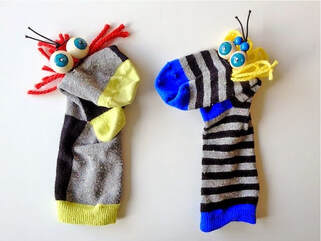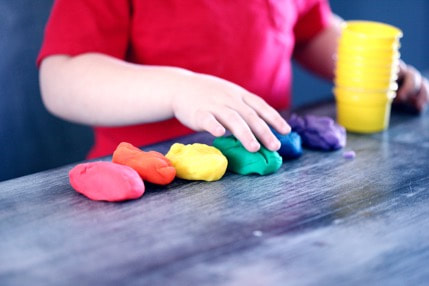Re-storying and Reconnecting
Re-authoring our Stories
|
- Expressive arts therapists witness the client's journey of self- discovery - the treasures that were found and the insight that was made through the art making process. They help clients explore these new treasures and put these new discoveries into action. It's important to explore: What we see, feel, and imagine; what we experience; and HOW we experience it.
- Similar to The Hero's Journey, expressive arts therapists have an aesthetic responsibility to guide clients through alternative, sensory experiences that can help them step back into their everyday lives with a renewed perspective – a new story that can drive positive change and connections.
Re-Storying
Role-play allows the participant to alter their mindset, act out in new ways, and connect their own experiences to those of another person. Two types of Role-Playing:
- Scripted Role
- Participants act as another person, usually based on a script or text describing the individual. The participant studies the role, attempts to understand the individual, and often finds that they can relate to certain factors in the character’s experience.
- Improvisational Role
- Participants are given minimal guidance on the character and allowed to create their personality spontaneously. The participant typically draws from their own experiences, memories, and assumptions to create a personality, making it an exercise in self-expression, whether the actor is aware of each aspect of their self that seeps through or not (Ackerman, 2018).
Sand Tray (example)
- “Clients have the opportunity to resolve traumas through externalizing their fantasies and developing a sense of relationship and control over inner impulses” (Kaduson & Schaefer, 2015). A sand tray is created, along with numerous miniature toys and objects are made available to clients. Method: Clients are invited to play with the sand and choose from the miniatures, and create a story (Gladding, 2021, pp.209-210).
- Free Online Sand Tray: https://onlinesandtray.com/
Cartoon / Comic Creations (example)
- Allows room to externalize experiences through creating cartoons or comics, where client can physically put a box around those experiences to put them on a shelf and separate from the person.
- Offers method of artistic expression of one’s inner view, and allows client to examine their abstract and complex encounters, emotions, thoughts, and behaviors.
- Method: Ask the client to reflect on a specific event or time they faced an obstacle.
- Then construct a cartoon or comic strip that is based on that experience. Ask the client to illustrate all the emotions, transcript, and the environment for that incident. Allow time for reflection and processing (Elswick, 2019, pp.144-145).
My Artistic Point of View (example)
This intervention is designed to help tell a story, describe a point of view, or express feelings. Clients will use their artistic abilities to create a picture that relates to a specific topic or event to help convey their point of view.
Method: The client will be given/choose a scenario, a topic, or an emotion. The client will then be offered several medias to choose from, and create what comes to mind
After completion, clients are invited to describe their artwork and how it relates to the subject (Elswick, 2019, p.100).
Method: The client will be given/choose a scenario, a topic, or an emotion. The client will then be offered several medias to choose from, and create what comes to mind
After completion, clients are invited to describe their artwork and how it relates to the subject (Elswick, 2019, p.100).
Masks (example)
“Donning a mask can help participants feel safer and more secure, as well as give them another way to express themselves and share their feelings with others nonverbally.
There are four main ways in which a mask can be used in a therapeutic encounter (Landy, 1986):
There are four main ways in which a mask can be used in a therapeutic encounter (Landy, 1986):
- To represent two sides of a conflict or dilemma
- To express one’s identity in a group
- To explore dreams and imagery
- To express a social role
Imagery and Visual Arts
The links and articles on this page provide a broad overview of using the Visual Arts in Counseling. There are many more awesome websites and articles that are not listed.
Click here for PLAY THERPY resources
ARTICLES (IMAGERY)
ARTICLES (VISUAL ARTS)
- Cross, G., & Brown, P. M. (2019). A comparison of the positive effects of structured and nonstructured art activities. Art Therapy, 36(1), 22-29.
- Herndon, P., Myers, B., Mitchell, K., Kehn, A., & Henry, S. (2014). False memories for highly aversive early childhood events: Effects of guided imagery and group influence. Psychology of Consciousness: Theory, Research, and Practice, 1(1), 20–31. https://doi.org/10.1037/cns0000011
- McEvoy, P. M., Erceg-Hurn, D. M., Saulsman, L. M., & Thibodeau, M. A. (2015). Imagery enhancements increase the effectiveness of cognitive behavioural group therapy for social anxiety disorder: A benchmarking study. Behaviour Research and Therapy, 65, 42-51.
- Murphy, K. M., & Ziedonis, D. M. (2016). Group Guided Imagery and Music for Adults in Addiction Treatment: A Pilot Randomized Control Trial Feasibility Study. Journal of the Association for Music & Imagery, 15, 43–65.
- Sklare, G. B., Sabella, R. A., & Petrosko, J. M. (2003). A preliminary study of the effects of group solution-focused guided imagery on recurring individual problems. Journal for Specialists in Group Work, 28(4), 370-381.
- Sutton, J. (2022, November 26). Visualization in therapy: 16 simple techniques & tools. PositivePsychology.com. https://positivepsychology.com/visualization-techniques/
- Utay, J., & Miller, M. (2006). Guided Imagery as an Effective Therapeutic Technique: A Brief Review of its History and Efficacy Research. Journal of Instructional Psychology, 33(1).
ARTICLES (VISUAL ARTS)
- Brillantes-Evangelista, G. (2013). An evaluation of visual arts and poetry as therapeutic interventions with abused adolescents. The Arts in Psychotherapy, 40(1), 71-84.
- Catterall, J. S., & Peppler, K. A. (2007). Learning in the visual arts and the worldviews of young children. Cambridge Journal of Education, 37(4), 543-560.
- Elswick, S. (2019). Expressive Arts Toolkit Manual. University of Memphis .
- Gladding, S. T. (2021). The creative arts in counseling. John Wiley & Sons
- Johnson, C. M., & Sullivan-Marx, E. M. (2006). Art therapy: Using the creative process for healing and hope among African American older adults. Geriatric nursing, 27(5), 309-316.
- Green, B. L., Wehling, C., & Taisky, G. J. (1987). Group art therapy as an adjunct to treatment for chronic outpatients. Psychiatric Services, 38(9), 988-991.
- Kaduson, H. & Schaefer, C. (Eds.) (2015). Short-term play therapy for children (3rd ed.). Guilford Press.
- Macpherson, H., Hart, A., & Heaver, B. (2016). Building resilience through group visual arts activities: Findings from a scoping study with young people who experience mental health complexities and/or learning difficulties. Journal of Social Work, 16(5), 541-560.
- Nelson, C. L. (2010). Meeting the needs of urban students: Creative arts therapy in Jersey City public schools. Art Therapy, 27(2), 62-68.
- Parsons, A., Omylinska-Thurston, J., Karkou, V., Harlow, J., Haslam, S., Hobson, J., Nair, K., Dubrow-Marshall, L., Thurston, S., & Griffin, J. (2020). Arts for the blues – a new creative psychological therapy for depression. British Journal of Guidance & Counselling, 48(1), 5–20. https://doi.org/10.1080/03069885.2019.1633459
- Pretorius, G., & Pfeifer, N. (2010). Group art therapy with sexually abused girls. South African Journal of Psychology, 40(1), 63-73.
- Reynolds, M. W., Nabors, L., & Quinlan, A. (2000). The effectiveness of art therapy: does it work?. Art Therapy, 17(3), 207-213.
- Rouse, A., Armstrong, J., & McLeod, J. (2015). Enabling connections: Counsellor creativity and therapeutic practice. Counselling and Psychotherapy Research, 15(3), 171-179.
- Slayton, S. C. (2012). Building community as social action: An art therapy group with adolescent males. The Arts in Psychotherapy, 39(3), 179-185.
- Sonnone, A., & Rochford, J. S. (2020). Wellness at Universities: A Group Art Therapy Approach. Journal of College Counseling, 23(2), 168–179. https://doi.org/10.1002/jocc.12157
- Strom, E. (2020). Revisiting the arts as a socially innovative urban development strategy. European Planning Studies, 28(3), 475-495.
- Stuebing, M. D., Lorenz, H., & Littlefield, L. M. (2020). Literacy-free 12 step expressive arts curriculum enhances engagement and treatment outcomes for dually diagnosed substance use and mental health disorders. Alcoholism Treatment Quarterly, 38(2), 250-265.
- Veach, L. J., & Gladding, S. T. (2006). Using creative group techniques in high schools. The Journal for Specialists in Group Work, 32(1), 71-81.
- Coonfield, G. (2009). Storytelling as communication and ritual: Addiction narrative through a blue lens. Storytelling, Self, Society, 5(3), 176-192.
- Brown, B. (2021). Atlas of the heart: Mapping meaningful connection and the language of human experience. Random House.
- Delker, B. C., Salton, R., McLean, K. C., & Syed, M. (2020). Who has to tell their trauma story and how hard will it be? Influence of cultural stigma and narrative redemption on the storying of sexual violence. Plos one, 15(6), e0234201.
- Paterno, M. T., Low, M., Gubrium, A., & Sanger, K. (2019). Mothers and mentors: Exploring perinatal addiction and recovery through digital storytelling. Qualitative Health Research, 29(4), 545-556.
- Snyder, B. A. (2005). Aging and spirituality: Reclaiming connection through storytelling. Adultspan Journal, 4(1), 49-55.
- Kerr, C. (Ed.). (2011). Family art therapy: Foundations of theory and practice. Routledge.





